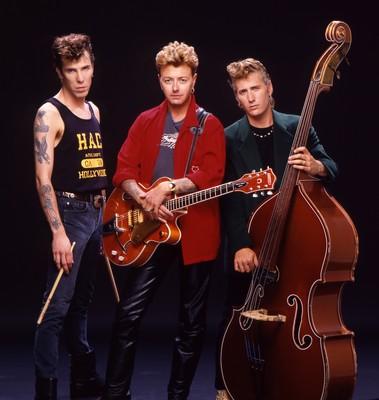Returning to the Road
Slim Jim Phantom's standing in the joint where Johnny Cash had his shirts made, and it's as if he's entered a cathedral of Americana.
Phantom's the kind of guy who savors the roots of rock 'n' roll the way he would his last meal, and he's currently standing on hallowed grounds of denim and leather.
"I'm right here in Manuel's famous tailor shop in Nashville," Phantom says on a recent Thursday afternoon while browsing through the wares at Manuel's Exclusive Clothier. "There's pictures on the wall here of Bob Dylan, Porter Wagoner, George Jones, Ricky Nelson. And we're here today. Americana, man, it's going strong."
And it's recently gotten another protein boost now that Phantom's band, veteran rockabilly trio the Stray Cats, have reunited for their first American tour in 15 years.
At the dawn of the '80s, the Stray Cats modernized the slick-haired, '50s-born rockabilly sound, jump-starting it with punk rock vigor and a nattily-attired MTV sheen.
The band served as a blood transfusion for the fading genre, reintroducing it to the top of the charts and laying the groundwork for a big revival in the years to come.
"Before the Stray Cats, when someone asked you what rockabilly was, you'd say, 'Well, it's taking a little bit of the '50s, but it's continuing with the modern thing, but we still pay homage to this ...' " Phantom says. "It was hard to explain. Now, it's become part of the modern language."
Of course, rockabilly's long been a part of the musical vocabulary, ever since the likes of Johnny Burnette, Carl Perkins and Elvis Presley wed a deep woods, honky-tonk stomp with a hot-under-the-collar R&B swing and fiercely slapped bass lines to form one of the most lasting amalgamations of American music.
It was rural and urban at once, equally primal and svelte, the gene code for rock 'n' roll.
As an aspiring rocker in New York City in the late '70s, Phantom got hooked on these vintage sounds while making the rounds in the city's underground rock dives.
"There was a jukebox at Max's Kansas City that had 'That's All Right Mama,' 'Blue Moon of Kentucky' and I'm saying, 'What's that?' " Phantom recalls. " 'That's Elvis Presley, dude.' 'Elvis Presley? Put that on again.' The room stopped spinning, the world stopped turning for a second, and I knew that this was what I had to do. Then you discover Carl Perkins and Gene Vincent and it's all over, forget it, you're in. I cut all my hair off, I bought a suit from the Salvation Army, and there it was."
Hooked on the sound, Phantom would join up with guitarist Brian Setzer and bassist Lee Rocker, longtime friends whom he'd known since the third grade, and they'd sweat out rockabilly jams as the Stray Cats on the weekends apart from their other bands.
With punk dominating the city at the time, the band had few peers.
"In New York, when we first started doing it, it was just us," Phantom says. "You could still go to the Salvation Army and buy bowling shirts for 50 cents. It wasn't in any way collectible or desirable. It was just the three of us, who lived in the same neighborhood and couldn't believe that there were two other guys who were like, 'You're into this too?' "
Eventually, the Stray Cats would evolve into a full-time gig and they'd help catalyze a distinct, fashion-conscious subculture, now a thriving community that fetishizes hot rods, cheap beer, dudes with greasy hair and gals who look like Betty Boop with neck tattoos.
From the onset, the Stray Cats were a very image-aware lot, reimagining vintage rockabilly's heavily stylized aesthetic with baggy pants, shredded T-shirts, skyscraper hairdos and enough leather to blanket Rhode Island.
For this bunch, though, it was fashion out of necessity.
"We all lived in a tiny, tiny apartment together that just had one giant pile of clothes in the corner," Phantom says with a chuckle. "Some days you'd be able to grab a pair of baggy pants, some days you'd be able to grab a cowboy shirt, and those are the two that you had to mix together. If someone wasn't wearing their leather jacket, you grabbed it first, but then you could only find red pants to go with that, so you had to grab those. We invented it as we went along."
And they cut a distinct swath in pop music along the way, going platinum with their 1982 U.S. debut, "Built for Speed," which was driven by top 10 hits like "Rock This Town" and "Stray Cat Strut."
After going their separate ways in the early '90s, right before rockabilly would reassert itself prominently in the indie rock underground, the Stray Cats have returned to the road.
Nowadays, they're making up for lost time, but then again, that's really what this band has been about from day one.
"This was a piece of American culture that was very much in danger of going away," Phantom says of rockabilly's fallow years in the '70s. "There's not that much stuff that we can truly lay claim to. We have the blues, we have jazz, we have baseball and we have rockabilly. I'm proud that we had the opportunity to do our bit for the cause."
JASON BRACELINMORE COLUMNS
who: The Stray Cats, with ZZ Top and the Pretenders when: 7 p.m. Saturday where: Orleans Arena, 4500 Tropicana Ave. tickets: $50-$90 (284-7777






















